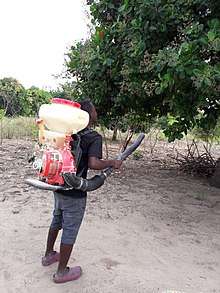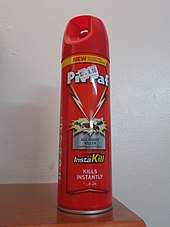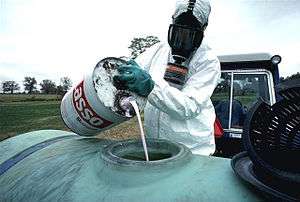Insecticide
Insecticides are substances used to kill insects.[1] They include ovicides and larvicides used against insect eggs and larvae, respectively. Insecticides are used in agriculture, medicine, industry and by consumers. Insecticides are claimed to be a major factor behind the increase in the 20th-century's agricultural productivity.[2] Nearly all insecticides have the potential to significantly alter ecosystems; many are toxic to humans and/or animals; some become concentrated as they spread along the food chain.



Insecticides can be classified into two major groups: systemic insecticides, which have residual or long term activity; and contact insecticides, which have no residual activity.
The mode of action describes how the pesticide kills or inactivates a pest. It provides another way of classifying insecticides. Mode of action can be important in understanding whether an insecticide will be toxic to unrelated species, such as fish, birds and mammals.
Insecticides may be repellent or non-repellent. Social insects such as ants cannot detect non-repellents and readily crawl through them. As they return to the nest they take insecticide with them and transfer it to their nestmates. Over time, this eliminates all of the ants including the queen. This is slower than some other methods, but usually completely eradicates the ant colony.[3]
Insecticides are distinct from non-insecticidal repellents, which repel but do not kill.
Type of activity
Systemic insecticides become incorporated and distributed systemically throughout the whole plant. When insects feed on the plant, they ingest the insecticide. Systemic insecticides produced by transgenic plants are called plant-incorporated protectants (PIPs). For instance, a gene that codes for a specific Bacillus thuringiensis biocidal protein was introduced into corn (maize) and other species. The plant manufactures the protein, which kills the insect when consumed.[4]
Contact insecticides are toxic to insects upon direct contact. These can be inorganic insecticides, which are metals and include the commonly used sulfur, and the less commonly used arsenates, copper and fluorine compounds. Contact insecticides can also be organic insecticides, i.e. organic chemical compounds, synthetically produced, and comprising the largest numbers of pesticides used today. Or they can be natural compounds like pyrethrum, neem oil etc. Contact insecticides usually have no residual activity.
Efficacy can be related to the quality of pesticide application, with small droplets, such as aerosols often improving performance.[5]
Biological pesticides
Many organic compounds are produced by plants for the purpose of defending the host plant from predation. A trivial case is tree rosin, which is a natural insecticide. Specifically, the production of oleoresin by conifer species is a component of the defense response against insect attack and fungal pathogen infection.[6] Many fragrances, e.g. oil of wintergreen, are in fact antifeedants.
Four extracts of plants are in commercial use: pyrethrum, rotenone, neem oil, and various essential oils[7]
Other biological approaches
Plant-incorporated protectants
Transgenic crops that act as insecticides began in 1996 with a genetically modified potato that produced the Cry protein, derived from the bacterium Bacillus thuringiensis, which is toxic to beetle larvae such as the Colorado potato beetle. The technique has been expanded to include the use of RNA interference RNAi that fatally silences crucial insect genes. RNAi likely evolved as a defense against viruses. Midgut cells in many larvae take up the molecules and help spread the signal. The technology can target only insects that have the silenced sequence, as was demonstrated when a particular RNAi affected only one of four fruit fly species. The technique is expected to replace many other insecticides, which are losing effectiveness due to the spread of pesticide resistance.[8]
Enzymes
Many plants exude substances to repel insects. Premier examples are substances activated by the enzyme myrosinase. This enzyme converts glucosinolates to various compounds that are toxic to herbivorous insects. One product of this enzyme is allyl isothiocyanate, the pungent ingredient in horseradish sauces.

The myrosinase is released only upon crushing the flesh of horseradish. Since allyl isothiocyanate is harmful to the plant as well as the insect, it is stored in the harmless form of the glucosinolate, separate from the myrosinase enzyme.[9]
Bacterial
Bacillus thuringiensis is a bacterial disease that affects Lepidopterans and some other insects. Toxins produced by strains of this bacterium are used as a larvicide against caterpillars, beetles, and mosquitoes. Toxins from Saccharopolyspora spinosa are isolated from fermentations and sold as Spinosad. Because these toxins have little effect on other organisms, they are considered more environmentally friendly than synthetic pesticides. The toxin from B. thuringiensis (Bt toxin) has been incorporated directly into plants through the use of genetic engineering. Other biological insecticides include products based on entomopathogenic fungi (e.g., Beauveria bassiana, Metarhizium anisopliae), nematodes (e.g., Steinernema feltiae) and viruses (e.g., Cydia pomonella granulovirus).
Synthetic insecticide and natural insecticides
A major emphasis of organic chemistry is the development of chemical tools to enhance agricultural productivity. Insecticides represent a major area of emphasis. Many of the major insecticides are inspired by biological analogues. Many others are not found in nature.
Organochlorides
The best known organochloride, DDT, was created by Swiss scientist Paul Müller. For this discovery, he was awarded the 1948 Nobel Prize for Physiology or Medicine.[10] DDT was introduced in 1944. It functions by opening sodium channels in the insect's nerve cells.[11] The contemporaneous rise of the chemical industry facilitated large-scale production of DDT and related chlorinated hydrocarbons.
Organophosphates and carbamates
Organophosphates are another large class of contact insecticides. These also target the insect's nervous system. Organophosphates interfere with the enzymes acetylcholinesterase and other cholinesterases, disrupting nerve impulses and killing or disabling the insect. Organophosphate insecticides and chemical warfare nerve agents (such as sarin, tabun, soman, and VX) work in the same way. Organophosphates have a cumulative toxic effect to wildlife, so multiple exposures to the chemicals amplifies the toxicity.[12] In the US, organophosphate use declined with the rise of substitutes.[13]
Carbamate insecticides have similar mechanisms to organophosphates, but have a much shorter duration of action and are somewhat less toxic.
Pyrethroids
Pyrethroid pesticides mimic the insecticidal activity of the natural compound pyrethrum, the biopesticide found in pyrethrins. These compounds are nonpersistent sodium channel modulators and are less toxic than organophosphates and carbamates. Compounds in this group are often applied against household pests.[14]
Neonicotinoids
Neonicotinoids are synthetic analogues of the natural insecticide nicotine (with much lower acute mammalian toxicity and greater field persistence). These chemicals are acetylcholine receptor agonists. They are broad-spectrum systemic insecticides, with rapid action (minutes-hours). They are applied as sprays, drenches, seed and soil treatments. Treated insects exhibit leg tremors, rapid wing motion, stylet withdrawal (aphids), disoriented movement, paralysis and death.[15] Imidacloprid may be the most common. It has recently come under scrutiny for allegedly pernicious effects on honeybees[16] and its potential to increase the susceptibility of rice to planthopper attacks.[17]
Butenolides
Butenolide pesticides are a novel group of chemicals, similar to neonicotinoids in their mode of action, that have so far only one representative: flupyradifurone. They are acetylcholine receptor agonists, like neonicotinoids, but with a different pharmacophore.[18] They are broad-spectrum systemic insecticides, applied as sprays, drenches, seed and soil treatments. Although the classic risk assessment considered this insecticide group (and flupyradifurone specifically) safe for bees, novel research[19] have raised concern on their lethal and sublethal effects, alone or in combination with other chemicals or environmental factors.[20][21]
Ryanoids
Ryanoids are synthetic analogues with the same mode of action as ryanodine, a naturally occurring insecticide extracted from Ryania speciosa (Flacourtiaceae). They bind to calcium channels in cardiac and skeletal muscle, blocking nerve transmission. The first insecticide from this class to be registered was Rynaxypyr, generic name chlorantraniliprole.[22]
Insect growth regulators
Insect growth regulator (IGR) is a term coined to include insect hormone mimics and an earlier class of chemicals, the benzoylphenyl ureas, which inhibit chitin (exoskeleton) biosynthesis in insects[23] Diflubenzuron is a member of the latter class, used primarily to control caterpillars that are pests. The most successful insecticides in this class are the juvenoids (juvenile hormone analogues). Of these, methoprene is most widely used. It has no observable acute toxicity in rats and is approved by World Health Organization (WHO) for use in drinking water cisterns to combat malaria. Most of its uses are to combat insects where the adult is the pest, including mosquitoes, several fly species, and fleas. Two very similar products, hydroprene and kinoprene, are used for controlling species such as cockroaches and white flies. Methoprene was registered with the EPA in 1975. Virtually no reports of resistance have been filed. A more recent type of IGR is the ecdysone agonist tebufenozide (MIMIC), which is used in forestry and other applications for control of caterpillars, which are far more sensitive to its hormonal effects than other insect orders.
Environmental harm
Effects on nontarget species
Some insecticides kill or harm other creatures in addition to those they are intended to kill. For example, birds may be poisoned when they eat food that was recently sprayed with insecticides or when they mistake an insecticide granule on the ground for food and eat it.[12] Sprayed insecticide may drift from the area to which it is applied and into wildlife areas, especially when it is sprayed aerially.[12]
DDT
The development of DDT was motivated by desire to replace more dangerous or less effective alternatives. DDT was introduced to replace lead and arsenic-based compounds, which were in widespread use in the early 1940s.[24]
DDT was brought to public attention by Rachel Carson's book Silent Spring. One side-effect of DDT is to reduce the thickness of shells on the eggs of predatory birds. The shells sometimes become too thin to be viable, reducing bird populations. This occurs with DDT and related compounds due to the process of bioaccumulation, wherein the chemical, due to its stability and fat solubility, accumulates in organisms' fatty tissues. Also, DDT may biomagnify, which causes progressively higher concentrations in the body fat of animals farther up the food chain. The near-worldwide ban on agricultural use of DDT and related chemicals has allowed some of these birds, such as the peregrine falcon, to recover in recent years. A number of organochlorine pesticides have been banned from most uses worldwide. Globally they are controlled via the Stockholm Convention on persistent organic pollutants. These include: aldrin, chlordane, DDT, dieldrin, endrin, heptachlor, mirex and toxaphene.
Runoff and Percolation
Solid bait and liquid insecticides, especially if improperly applied in a location, get moved by water flow. Often, this happens through nonpoint sources where runoff carries insecticides in to larger bodies of water. As snow melts and rainfall moves over and through the ground, the water picks applied insecticides and deposits them in to larger bodies of water, rivers, wetlands, underground sources of previously potable water, and percolates in to watersheds.[25] This runoff and percolation of insecticides can effect the quality of water sources, harming the natural ecology and thus, indirectly effect human populations through biomagnification and bioaccumulation.
Pollinator decline
Insecticides can kill bees and may be a cause of pollinator decline, the loss of bees that pollinate plants, and colony collapse disorder (CCD),[26] in which worker bees from a beehive or Western honey bee colony abruptly disappear. Loss of pollinators means a reduction in crop yields.[26] Sublethal doses of insecticides (i.e. imidacloprid and other neonicotinoids) affect bee foraging behavior.[27] However, research into the causes of CCD was inconclusive as of June 2007.[28]
Bird decline
Besides the effects of direct consumption of insecticides, populations of insectivorous birds decline due to the collapse of their prey populations. Spraying of especially wheat and corn in Europe is believed to have caused an 80 per cent decline in flying insects, which in turn has reduced local bird populations by one to two thirds.[29]
Alternatives
Instead of using chemical insecticides to avoid crop damage caused by insects, there are many alternative options available now that can protect farmers from major economic losses.[30] Some of them are:
- Breeding crops resistant, or at least less susceptible, to pest attacks.[31]
- Releasing predators, parasitoids, or pathogens to control pest populations as a form of biological control.[32]
- Chemical control like releasing pheromones into the field to confuse the insects into not being able to find mates and reproduce.[33]
- Integrated Pest Management: using multiple techniques in tandem to achieve optimal results.[34]
- Push-pull technique: intercropping with a "push" crop that repels the pest, and planting a "pull" crop on the boundary that attracts and traps it.[35]
Examples
See also
- Integrated pest management
- Fogger
- Index of pesticide articles
- Endangered arthropod
- Pesticide application
References
- IUPAC (2006). "Glossary of Terms Relating to Pesticides" (PDF). IUPAC. p. 2123. Retrieved January 28, 2014.
- van Emden, H.F.; Peakall, David B. (30 June 1996). Beyond Silent Spring. Springer. ISBN 978-0-412-72800-6.
- "Non-Repellent insecticides". Do-it-yourself Pest Control. Retrieved 20 April 2017.
- "United States Environmental Protection Agency - US EPA".
- "dropdata.org". dropdata.org. Retrieved 2011-01-05.
- Trapp, S.; Croteau, R. (2001). "Defensive Biosynthesis of Resin in Conifers". Annual Review of Plant Physiology and Plant Molecular Biology. 52 (1): 689–724. doi:10.1146/annurev.arplant.52.1.689. PMID 11337413.
- Isman Murray B (2006). "Botanical Insecticides, Deterrents, And Repellents In Modern Agriculture And An Increasingly Regulated World". Annual Review of Entomology. 51: 45–66. doi:10.1146/annurev.ento.51.110104.151146. PMID 16332203.
- Kupferschmidt, K. (2013). "A Lethal Dose of RNA". Science. 341 (6147): 732–3. Bibcode:2013Sci...341..732K. doi:10.1126/science.341.6147.732. PMID 23950525.
- Cole Rosemary A (1976). "Isothiocyanates, nitriles and thiocyanates as products of autolysis of glucosinolates in Cruciferae". Phytochemistry. 15 (5): 759–762. doi:10.1016/S0031-9422(00)94437-6.
- Karl Grandin, ed. (1948). "Paul Müller Biography". Les Prix Nobel. The Nobel Foundation. Retrieved 2008-07-24.
- Vijverberg; et al. (1982). "Similar mode of action of pyrethroids and DDT on sodium channel gating in myelinated nerves". Nature. 295 (5850): 601–603. Bibcode:1982Natur.295..601V. doi:10.1038/295601a0. PMID 6276777.
- Palmer, WE, Bromley, PT, and Brandenburg, RL. Wildlife & pesticides - Peanuts. North Carolina Cooperative Extension Service. Retrieved on 14 October 2007.
- "Infographic: Pesticide Planet". Science. 341 (6147): 730–731. 2013. Bibcode:2013Sci...341..730.. doi:10.1126/science.341.6147.730. PMID 23950524.
- Class, Thomas J.; Kintrup, J. (1991). "Pyrethroids as household insecticides: analysis, indoor exposure and persistence". Fresenius' Journal of Analytical Chemistry. 340 (7): 446–453. doi:10.1007/BF00322420.
- Fishel, Frederick M. (9 March 2016). "Pesticide Toxicity Profile: Neonicotinoid Pesticides".
- Insecticides taking toll on honeybees Archived 2012-03-18 at the Wayback Machine
- Yao, Cheng; Shi, Zhao-Peng; Jiang, Li-Ben; Ge, Lin-Quan; Wu, Jin-Cai; Jahn, Gary C. (20 January 2012). "Possible connection between imidacloprid-induced changes in rice gene transcription profiles and susceptibility to the brown plant hopper Nilaparvata lugens Stål (Hemiptera: Delphacidae)". Pesticide Biochemistry and Physiology. 102 (3): 213–219. doi:10.1016/j.pestbp.2012.01.003. ISSN 0048-3575. PMC 3334832. PMID 22544984. Archived from the original on 24 May 2013.
- Nauen, Ralf; Jeschke, Peter; Velten, Robert; Beck, Michael E; Ebbinghaus-Kintscher, Ulrich; Thielert, Wolfgang; Wölfel, Katharina; Haas, Matthias; Kunz, Klaus; Raupach, Georg (June 2015). "Flupyradifurone: a brief profile of a new butenolide insecticide". Pest Management Science. 71 (6): 850–862. doi:10.1002/ps.3932. PMC 4657471. PMID 25351824.
- "Pesticide Marketed as Safe for Bees Harms Them in Study". The Scientist Magazine®. Retrieved 2020-08-01.
- Tosi, S.; Nieh, J. C. (2019-04-10). "Lethal and sublethal synergistic effects of a new systemic pesticide, flupyradifurone (Sivanto®), on honeybees". Proceedings of the Royal Society B: Biological Sciences. 286 (1900): 20190433. doi:10.1098/rspb.2019.0433. PMC 6501679. PMID 30966981.
- Tong, Linda; Nieh, James C.; Tosi, Simone (2019-12-01). "Combined nutritional stress and a new systemic pesticide (flupyradifurone, Sivanto®) reduce bee survival, food consumption, flight success, and thermoregulation". Chemosphere. 237: 124408. doi:10.1016/j.chemosphere.2019.124408. ISSN 0045-6535.
- "Pesticide Fact Sheet- chlorantraniliprole" (PDF). epa.gov. Retrieved 2011-09-14.
- Krysan, James; Dunley, John. "Insect Growth Regulators". Retrieved 20 April 2017.
- Metcalf, Robert L. (2002). "Insect Control". Ullmann's Encyclopedia of Industrial Chemistry. Wiley-VCH. doi:10.1002/14356007.a14_263. ISBN 978-3527306732.
- Environmental Protection Agency (2005). "Protecting Water Quality from Agricultural Runoff" (PDF). EPA.gov. Retrieved 2019-11-19.
- Wells M (March 11, 2007). "Vanishing bees threaten US crops". www.bbc.co.uk. BBC News. Retrieved 19 September 2007.
- Colin, M. E.; Bonmatin, J. M.; Moineau, I.; et al. (2004). "A method to quantify and analyze the foraging activity of honey bees: Relevance to the sublethal effects induced by systemic insecticides". Archives of Environmental Contamination and Toxicology. 47 (3): 387–395. doi:10.1007/s00244-004-3052-y. PMID 15386133.
- Oldroyd, B.P. (2007). "What's Killing American Honey Bees?". PLOS Biology. 5 (6): e168. doi:10.1371/journal.pbio.0050168. PMC 1892840. PMID 17564497.
- "Catastrophic collapse in farmland bird populations across France". BirdGuides. 21 March 2018. Retrieved 27 March 2018.
- Aidley, David (Summer 1976). "Alternatives to insecticides". Science Progress. 63 (250): 293–303. JSTOR 43420363. PMID 1064167.
- Russell, GE (1978). Plant Breeding for Pest and Disease Resistance. Elsevier. ISBN 978-0-408-10613-9.
- "Biological Control and Natural Enemies of Invertebrates Management Guidelines--UC IPM". ipm.ucanr.edu. Retrieved 2018-12-12.
- "Mating Disruption". jenny.tfrec.wsu.edu. Retrieved 2018-12-12.
- "Defining IPM | New York State Integrated Pest Management". nysipm.cornell.edu. Retrieved 2018-12-12.
- Cook, Samantha M.; Khan, Zeyaur R.; Pickett, John A. (2007). "The use of push-pull strategies in integrated pest management". Annual Review of Entomology. 52: 375–400. doi:10.1146/annurev.ento.52.110405.091407. ISSN 0066-4170. PMID 16968206.
- "Cinnamon Oil Kills Mosquitoes". www.sciencedaily.com. Retrieved 5 August 2008.
- "Cornelia Dick-Pfaff: Wohlriechender Mückentod, 19.07.2004".
- "Oregano Oil Works As Well As Synthetic Insecticides To Tackle Common Beetle Pest". www.sciencedaily.com. Retrieved 23 May 2008.
- "Almond farmers seek healthy bees". BBC News. 2006-03-08. Retrieved 2010-01-05.
Further reading
- McWilliams James E (2008). "'The Horizon Opened Up Very Greatly': Leland O. Howard and the Transition to Chemical Insecticides in the United States, 1894–1927". Agricultural History. 82 (4): 468–95. doi:10.3098/ah.2008.82.4.468. PMID 19266680.
External links
| Look up insecticide in Wiktionary, the free dictionary. |
| Wikisource has the text of the 1920 Encyclopedia Americana article Insecticide. |
- InsectBuzz.com - Daily updated news on insects and their relatives, including information on insecticides and their alternatives
- International Pesticide Application Research Centre (IPARC)
- Pestworld.org – Official site of the National Pest Management Association
- Streaming online video about efforts to reduce insecticide use in rice in Bangladesh. on Windows Media Player, on RealPlayer
- How Insecticides Work – Has a thorough explanation on how insecticides work.
- University of California Integrated pest management program
- Using Insecticides, Michigan State University Extension
- Example of Insecticide application in the Tsubo-en Zen garden (Japanese dry rock garden) in Lelystad, The Netherlands.

